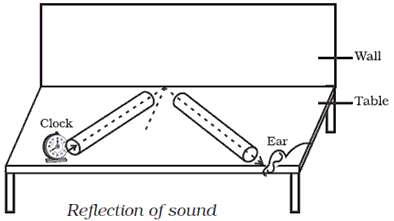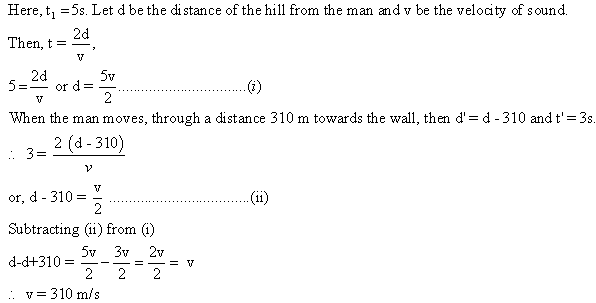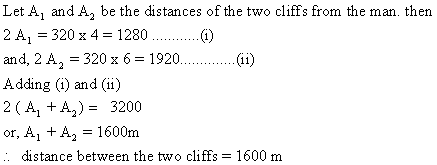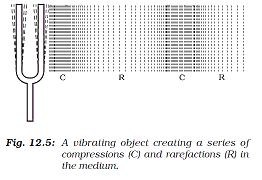FRANK Solutions for Class 10 Physics Chapter 3.1 - Characteristics of Wave Motion and Echoes
Chapter 3.1 - Characteristics of Wave Motion and Echoes Exercise 135
Question 1
Distinguish between longitudinal and transverse waves.
Solution 1
| Longitudinal waves | Transverse waves |
| 1. As it travels through a medium, the particles of the medium vibrate to and fro about their mean positions along the direction of propagation of wave. 2. As the wave propagates through the medium, it causes compressions and rarefactions. 3. In case of longitudinal waves, one wavelength contains one compression and one rarefaction. 4. They can travel through all media i.e. solids, liquids and gases. 5. As the longitudinal wave propagates through a medium, there is change in density of the medium. |
1. As it travels through a medium, the particles of the medium vibrate perpendicular to the direction of propagation of wave. 2. As the wave propagates through the medium, it produces crests and troughs. 3. In case of transverse waves, one wavelength contains one crest and one trough. 4. They can travel only through solids and on the surface of liquids. 5. As the transverse wave travels through a medium, there is no change in density of the medium. |
Question 2
What do you understand by amplitude of an oscillation?
Solution 2
The amplitude of an oscillation is the height of a crest or the depth of a trough measured from the mean position. The SI unit of amplitude is metre.
Question 3
Write down the relation between wavelength, frequency and wave-velocity.
Solution 3
Wave-velocity = wavelength x frequency
Question 4
State two factors on which the velocity of a wave depends.
Solution 4
The velocity of a wave in a medium depends on the elasticity and density of the medium.
Question 5
How does the velocity of a wave vary with temperature?
Solution 5
The velocity of a wave increases with the increase in temperature.
Question 6
The speed of a wave is 350 ms-1. Find the wavelength of the wave whose frequency is 700 Hz.
Solution 6

Chapter 3.1 - Characteristics of Wave Motion and Echoes Exercise 136
Question 1
What is the nature of sound waves?
Solution 1
Sound waves are mechanical in nature.
Question 2
Which has a greater speed: mechanical wave or electromagnetic wave?
Solution 2
Electromagnetic waves have greater speed.
Question 3
Can sound waves pass through vacuum?
Solution 3
Sound waves being mechanical waves need a material medium for their propagation, they cannot travel in vacuum.
Question 4
What are characteristics of a wave motion?
Solution 4
Characteristics of wave motion:
1. Wave motion can be produced only in a medium having elasticity and inertia.
2. When energy is given to any part of a medium, disturbance is produced in it by repeated periodic motion of the particles about their equilibrium positions.
3. During wave motion, no matter is transferred. It is only the energy that gets transferred.
4. The velocity of the wave relative to the medium depends only on the nature of the medium and not on the nature or motion of source of disturbance.
5. The velocity of the wave is different from the velocity with which the particles of the medium vibrate about their equilibrium positions.
6. Energy gets transferred from one particle of a medium to the next particle in a fixed interval of time.
7. The energy associated with the wave is the kinetic and potential energy of the matter.
1. Wave motion can be produced only in a medium having elasticity and inertia.
2. When energy is given to any part of a medium, disturbance is produced in it by repeated periodic motion of the particles about their equilibrium positions.
3. During wave motion, no matter is transferred. It is only the energy that gets transferred.
4. The velocity of the wave relative to the medium depends only on the nature of the medium and not on the nature or motion of source of disturbance.
5. The velocity of the wave is different from the velocity with which the particles of the medium vibrate about their equilibrium positions.
6. Energy gets transferred from one particle of a medium to the next particle in a fixed interval of time.
7. The energy associated with the wave is the kinetic and potential energy of the matter.
Question 5
Is energy transferred during wave motion?
Solution 5
Yes, energy is transferred during wave motion.
Question 6
Distinguish between mechanical and electromagnetic waves.
Solution 6

Question 7
Can a transverse wave travel in air?
Solution 7
No, transverse waves cannot travel in air. They can only travel in media which posses rigidity.
Question 8
Define wavelength. Give its SI units.
Solution 8
The wavelength is the distance between two successive crests or two successive troughs on a transverse wave.
It is also equal to the distance between any two points where the particles are passing through their respective mean positions in the same direction.
It is also the distance between two successive compressions or two successive rarefactions on a longitudinal wave.
The SI unit of wavelength is metre (m).
It is also equal to the distance between any two points where the particles are passing through their respective mean positions in the same direction.
It is also the distance between two successive compressions or two successive rarefactions on a longitudinal wave.
The SI unit of wavelength is metre (m).
Question 9
What is the range of hearing for a normal person?
Solution 9
Range of hearing of a normal person is 20 Hz to 20,000 Hz which is called the range of audibility.
Question 10
Define an echo.
Solution 10
The sound heard after reflection from a rigid obstacle (such as cliff, a hillside, a wall of a building, edge of a forest etc.), is called an echo.
Question 11
What is the full form of SONAR?
Solution 11
Full form of SONAR is 'sound navigation and ranging'.
Question 12
What is the full form of RADAR?
Solution 12
Full form of RADAR is 'radio detection and ranging'.
Question 13
Name the principle used to find the depth of a sea.
Solution 13
The depth of a sea can be found by the process of 'echo depth sounding'. This process is based on the principle of 'echo formation'.
Question 14
What are ultrasonic?
Solution 14
The sound wave of frequency higher than 20,000 Hz is called ultrasonic.
Question 15
What are infrasonics?
Solution 15
The sound wave of frequency below 20 Hz is called infrasonic.
Question 16
Give two applications of supersonics.
Solution 16
Applications of supersonics:
1. Jet aircrafts
2. Rockets
1. Jet aircrafts
2. Rockets
Question 17
What is the difference between echo and reverberation?
Solution 17
The sound heard after reflection from a rigid obstacle is called an echo. To hear the cho of a sound distinctly, the reflecting surface in air should be at a minimum distance of 17 m from the listener.
If the distance is less than 17 m, the reflected sound will reach the ears before the original sound dies out. In such a case, the original sound mixes up with the reflected sound. Due to repeated reflections at the reflecting surface, the sound gets prolonged. This effect is known as reverberation.
If the distance is less than 17 m, the reflected sound will reach the ears before the original sound dies out. In such a case, the original sound mixes up with the reflected sound. Due to repeated reflections at the reflecting surface, the sound gets prolonged. This effect is known as reverberation.
Question 18
What are the conditions necessary for the formation of echo?
Solution 18
Conditions necessary for echo formation are:
1. The minimum distance between the source of sound and its reflector should be 17 m.
2. Reflected sound should reach the person atleast 0.1 second after the original sound is heard.
1. The minimum distance between the source of sound and its reflector should be 17 m.
2. Reflected sound should reach the person atleast 0.1 second after the original sound is heard.
Question 19
What are the lowest and highest limits of frequencies of sound which is audible to a human ear?
Solution 19
The lowest frequency audible to human ear is 20 Hz and the highest frequency audible to human ear is 20,000 Hz.
Question 20
Can sound waves be reflected?
Solution 20
Yes, sound waves can be reflected.
Question 21
Give a simple experiment to demonstrate the reflection of sound waves.
Solution 21
Experiment to demonstrate the reflection of sound:
1. Take two identical pipes, as shown in Fig. You can make the pipes using chart paper. The length of the pipes should be sufficiently long as shown.
2. Arrange them on a table near a wall.
3. Keep a clock near the open end of one of the pipes and try to hear the sound of the clock through the other pipe.
4. Adjust the position of the pipes so that you can best hear the sound of the clock.

Conclusion: Sound waves pass down the first tube and are reflected from the smooth surface of the wall. After reflection, they enter the second tube and are received by the ear at the other end. If you measure the angle of incidence and angle of reflection, you will notice that they are equal.
1. Take two identical pipes, as shown in Fig. You can make the pipes using chart paper. The length of the pipes should be sufficiently long as shown.
2. Arrange them on a table near a wall.
3. Keep a clock near the open end of one of the pipes and try to hear the sound of the clock through the other pipe.
4. Adjust the position of the pipes so that you can best hear the sound of the clock.

Conclusion: Sound waves pass down the first tube and are reflected from the smooth surface of the wall. After reflection, they enter the second tube and are received by the ear at the other end. If you measure the angle of incidence and angle of reflection, you will notice that they are equal.
Question 22
How will you find the velocity of sound waves?
Solution 22
A simple method for finding the velocity of sound is echo or open air method.
For example: A person stands at a known distance (d m) from a cliff and fires a pistol and simultaneously starts the stop watch. He stops the stop-watch as soon as he hears the echo. The distance traveled by sound during this time (t seconds) is twice the distance (2d m). The velocity (v) of sound is then calculated as under:

By repeating the experiment two or three times, the average velocity of sound can be calculated.
For example: A person stands at a known distance (d m) from a cliff and fires a pistol and simultaneously starts the stop watch. He stops the stop-watch as soon as he hears the echo. The distance traveled by sound during this time (t seconds) is twice the distance (2d m). The velocity (v) of sound is then calculated as under:
By repeating the experiment two or three times, the average velocity of sound can be calculated.
Question 23
Explain how the principle of echo is used by
(i) The bat during its flight at
(ii) The dolphin to locate small fish as its prey.
(i) The bat during its flight at
(ii) The dolphin to locate small fish as its prey.
Solution 23
(i) Bats can produce and detect the sound of very high frequency. The bats fly with speed much lower than the speed of sound. The sounds produced by flying bats get reflected from any obstacle in front of it. By hearing the echoes, bats come to know where the obstacles are, even in the dark. So, they can fly safely without colliding with the obstacles. This process of detecting obstacles is called sound ranging.
(ii) Dolphins detect their enemies and small fishes by emitting ultrasonic waves in all directions and then hearing their reflected sound i.e. echo. Dolphins can judge the nature of obstacles or of small fish by hearing the echo and catch their prey.
(ii) Dolphins detect their enemies and small fishes by emitting ultrasonic waves in all directions and then hearing their reflected sound i.e. echo. Dolphins can judge the nature of obstacles or of small fish by hearing the echo and catch their prey.
Question 24
What do you understand by sound signalling?
Solution 24
The process of sending ultrasonic waves in all directions to detect obstacles and hearing the echo is called sound signaling.
Question 25
What do you mean by sound ranging?
Solution 25
The process of detecting obstacles by sending ultrasonic waves and hearing the echo is called sound ranging.
Question 26
A man fires a gun and hears its echo after 5 s. The man then moves 310 m towards the hill and fires his gun again. This time he hears the echo after 3 s. Calculate the speed of sound.
Solution 26

Question 27
How do bats avoid obstacles in their way, when in flight?
Solution 27
Bats can produce and detect the sound of very high frequency. The bats fly with speed much lower than the speed of sound. The sounds produced by flying bats get reflected from any obstacle in front of it. By hearing the echoes, bats come to know where the obstacles are, even in the dark. So, they can fly safely without colliding with the obstacles. This process of detecting obstacles is called sound ranging.
Question 28
State the use of echo by a bat, dolphin and fisherman.
Solution 28
Bats, dolphins and fishermen use the principle of echo for locating obstacles and prey.
They produce and sent ultrasonic waves in all directions. When these waves are reflected back from the obstacles or prey, they hear the echo. From the time taken to hear the echo and from the nature of the sound received, bats, dolphins and fishermen are able to gauge the distance and type of surroundings.
They produce and sent ultrasonic waves in all directions. When these waves are reflected back from the obstacles or prey, they hear the echo. From the time taken to hear the echo and from the nature of the sound received, bats, dolphins and fishermen are able to gauge the distance and type of surroundings.
Question 29
What is sonar? State the principle on which it is based.
Solution 29
SONAR means sound navigation and ranging.
Sonar is an instrument that makes use of ultrasonic waves for sound ranging. It is equipped to measure even short time intervals quite accurately.
Sonar works on the principle of echoes. A strong and short (ultrasonic) sound signal is sent towards the bottom of ocean. The echo of this signal is then detected by it. By noting the time after which the reflected sound (echo) reaches back, we can calculate the depth of the ocean by using the formula.
Depth of ocean = v x t/2, here v is the velocity of ultrasonic wave.
Sonar is an instrument that makes use of ultrasonic waves for sound ranging. It is equipped to measure even short time intervals quite accurately.
Sonar works on the principle of echoes. A strong and short (ultrasonic) sound signal is sent towards the bottom of ocean. The echo of this signal is then detected by it. By noting the time after which the reflected sound (echo) reaches back, we can calculate the depth of the ocean by using the formula.
Depth of ocean = v x t/2, here v is the velocity of ultrasonic wave.
Question 30
Name the waves which are used in sonar to find the depth of sea.
Solution 30
Ultrasonic waves are sent in sonar to find the depth of the sea.
Question 31
A person standing between two vertical cliffs produces a sound. Two successive echoes are heard at 4 s and 6 s. Calculate the distance between the cliffs.
Solution 31

Question 32
Distinguish between crest and trough.
Solution 32
A transverse wave propagates by means of crests and troughs.
The high points of the waves are called crests or peaks and the low points of the waves are called troughs.
The high points of the waves are called crests or peaks and the low points of the waves are called troughs.
Question 33
What do you mean by wave-velocity?
Solution 33
The velocity with which a wave travels in a medium is referred to as wave-velocity.
Question 34
Distinguish between compression and rarefaction.
Solution 34
A longitudinal wave propagates by means of compressions and rarefactions.
When a vibrating object moves forward, it pushes and compresses the air in front of it creating a region of high pressure. This region is called a compression (C), as shown in Fig. This compression starts to move away from the vibrating object. When the vibrating object moves backwards, it creates a region of low pressure called rarefaction (R), as shown in Fig.

Compressions are the regions of high density where the particles of the medium come very close to each other and rarefactions are the regions of low density where the particles of the medium move away from each other.
When a vibrating object moves forward, it pushes and compresses the air in front of it creating a region of high pressure. This region is called a compression (C), as shown in Fig. This compression starts to move away from the vibrating object. When the vibrating object moves backwards, it creates a region of low pressure called rarefaction (R), as shown in Fig.

Compressions are the regions of high density where the particles of the medium come very close to each other and rarefactions are the regions of low density where the particles of the medium move away from each other.

0 comments:
Post a Comment